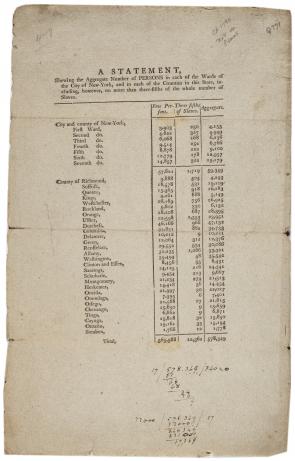Slavery in the New York State census, 1800
 While numbers do not explain the everyday realities of slavery in the eighteenth century, they do provide a sense of the pervasiveness of the peculiar institution even in a northern state like New York. This broadside provides figures from the 1800 census in New York. It offers a breakdown of the free population of each county in the state as well as three-fifths of the number of enslaved people present. The US Constitution permitted 60 percent, or three-fifths, of enslaved people to be counted toward the total population of each state in a compromise designed to provide the southern states with greater representation in Congress and the Electoral College.
While numbers do not explain the everyday realities of slavery in the eighteenth century, they do provide a sense of the pervasiveness of the peculiar institution even in a northern state like New York. This broadside provides figures from the 1800 census in New York. It offers a breakdown of the free population of each county in the state as well as three-fifths of the number of enslaved people present. The US Constitution permitted 60 percent, or three-fifths, of enslaved people to be counted toward the total population of each state in a compromise designed to provide the southern states with greater representation in Congress and the Electoral College.
It is well known that the "three-fifths clause" of the Constitution enhanced southern claims to power. However, what is less known is the North’s complicity in slavery, which is illustrated through these census numbers. While New York’s leaders had passed a bill for the gradual abolition of slavery in 1799, it was not fully implemented until 1827. Therefore, New York included 60 percent of those held in bondage within its borders in the census counts of 1800, 1810, and 1820. The number of enslaved people in New York was minuscule compared to the number held in the South, however; the three-fifths of those enslaved (equaling 12,362 persons in the census) counted in New York in 1800 was not enough for even half a seat in the House of Representatives.
